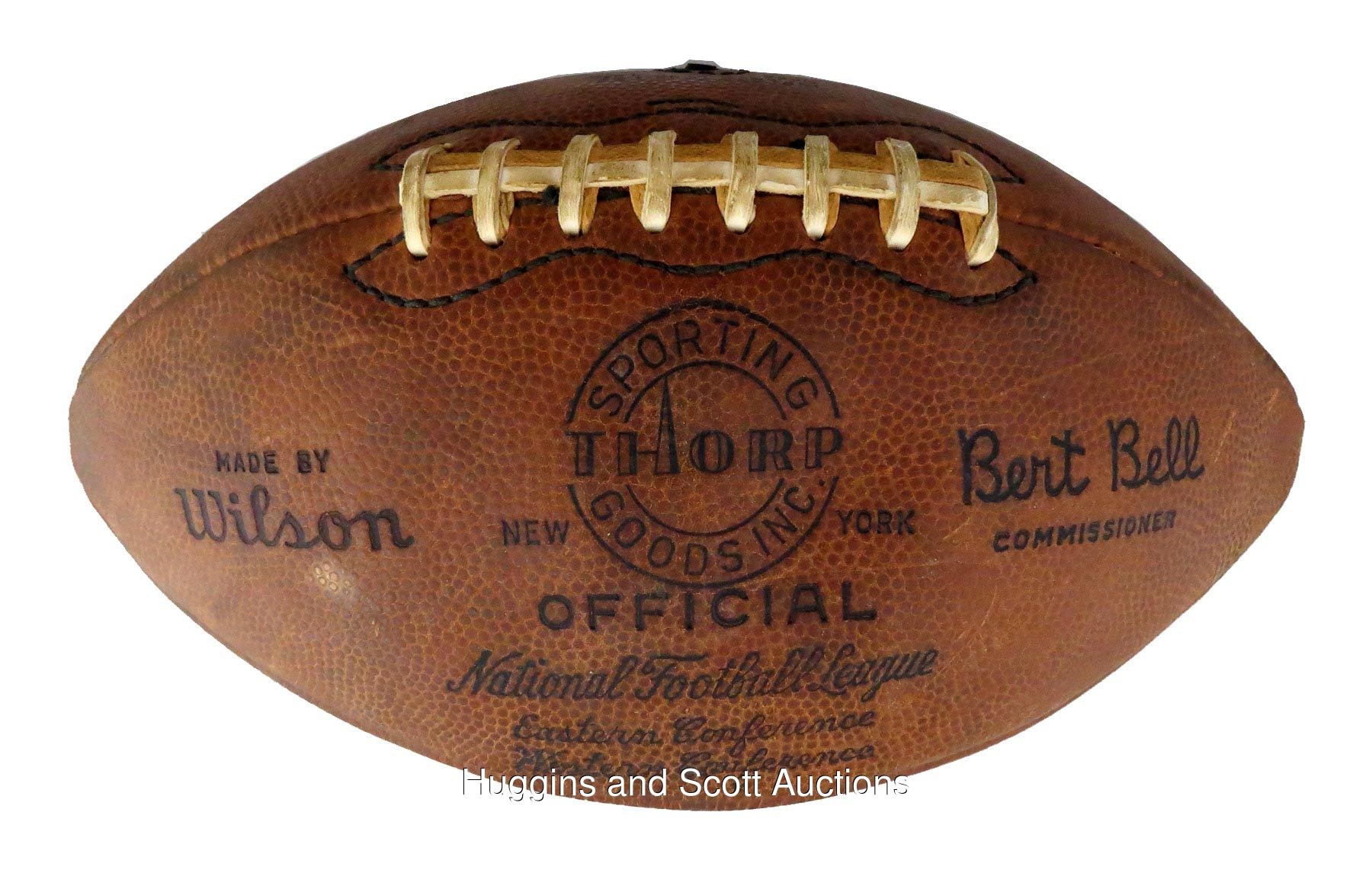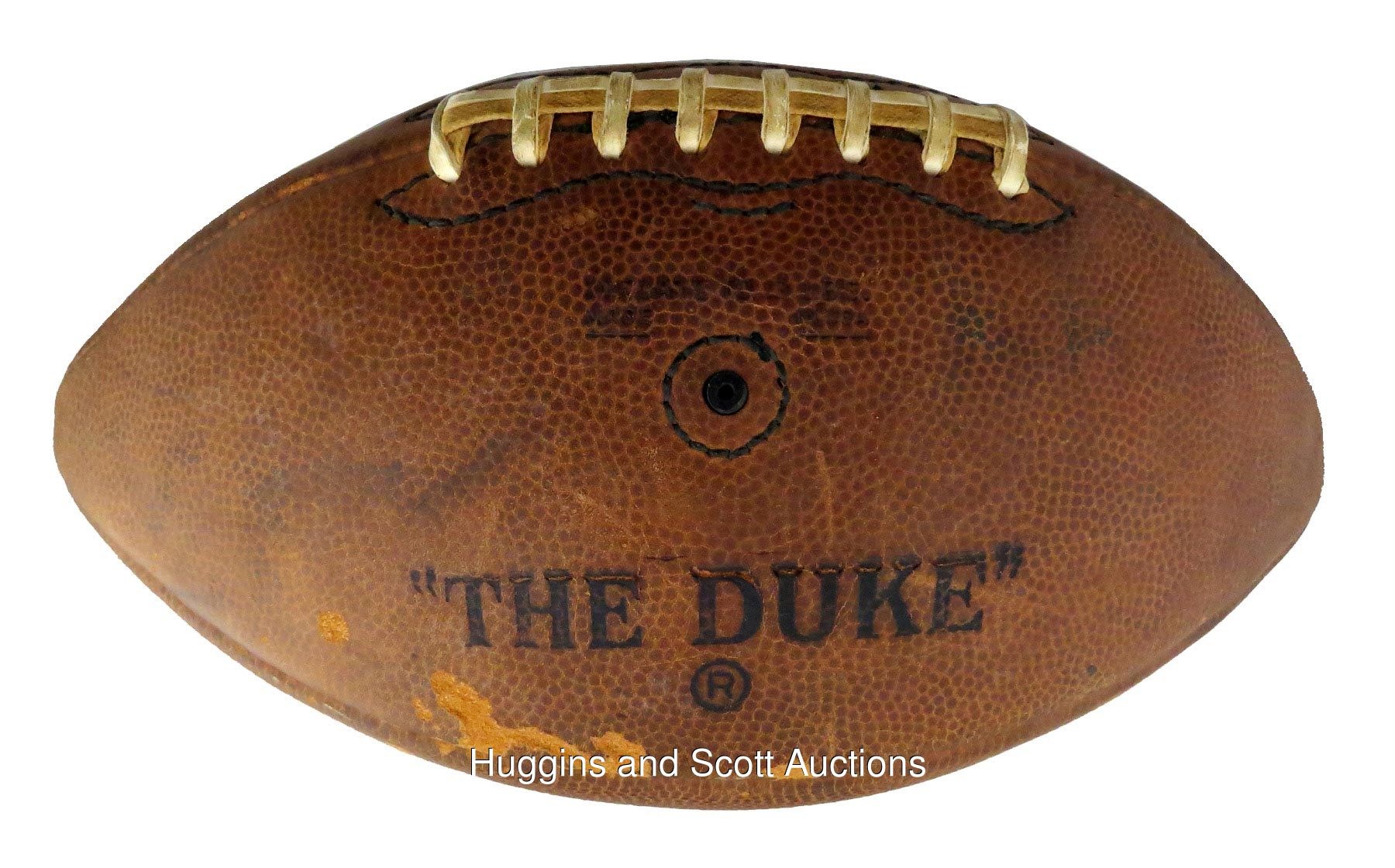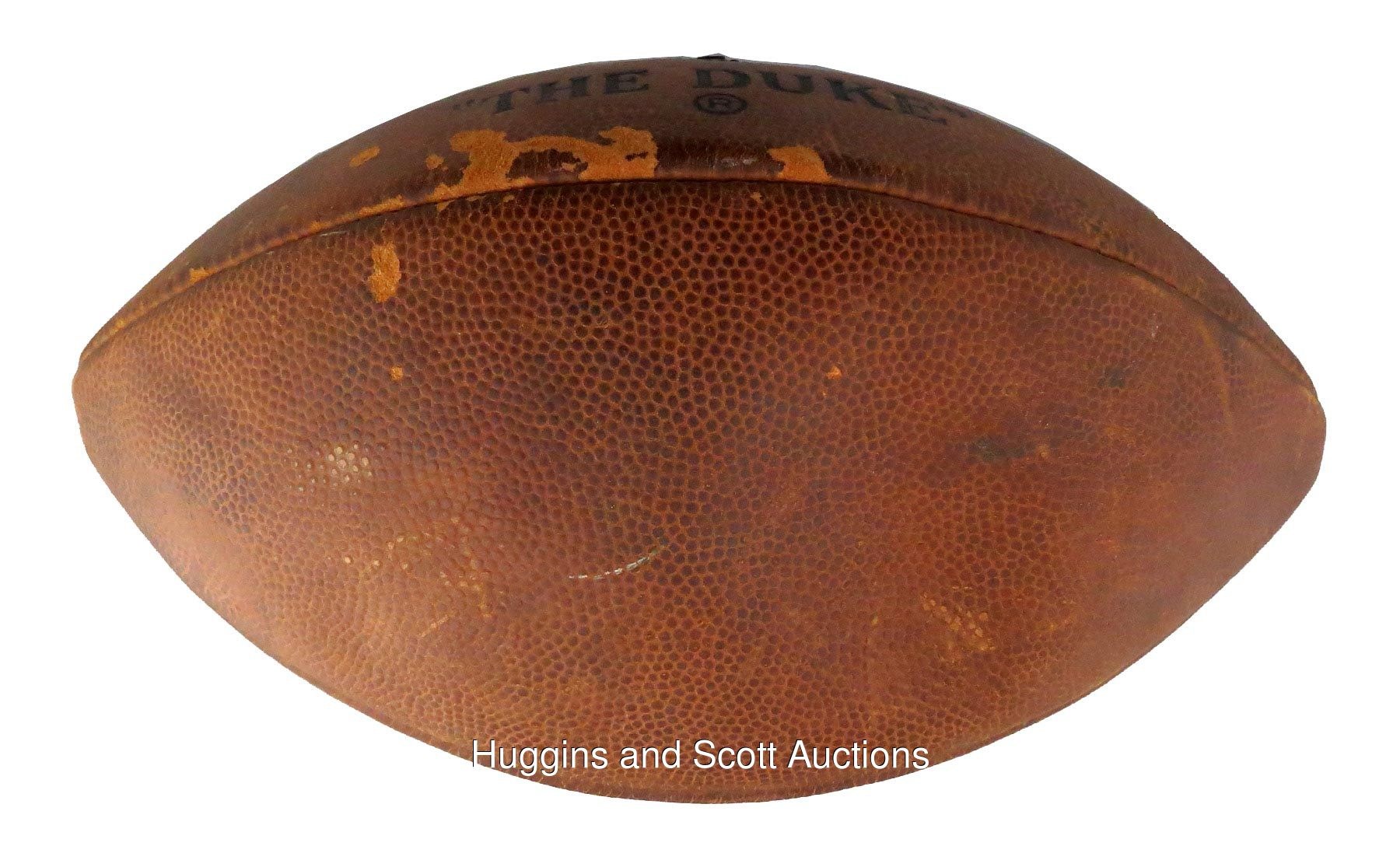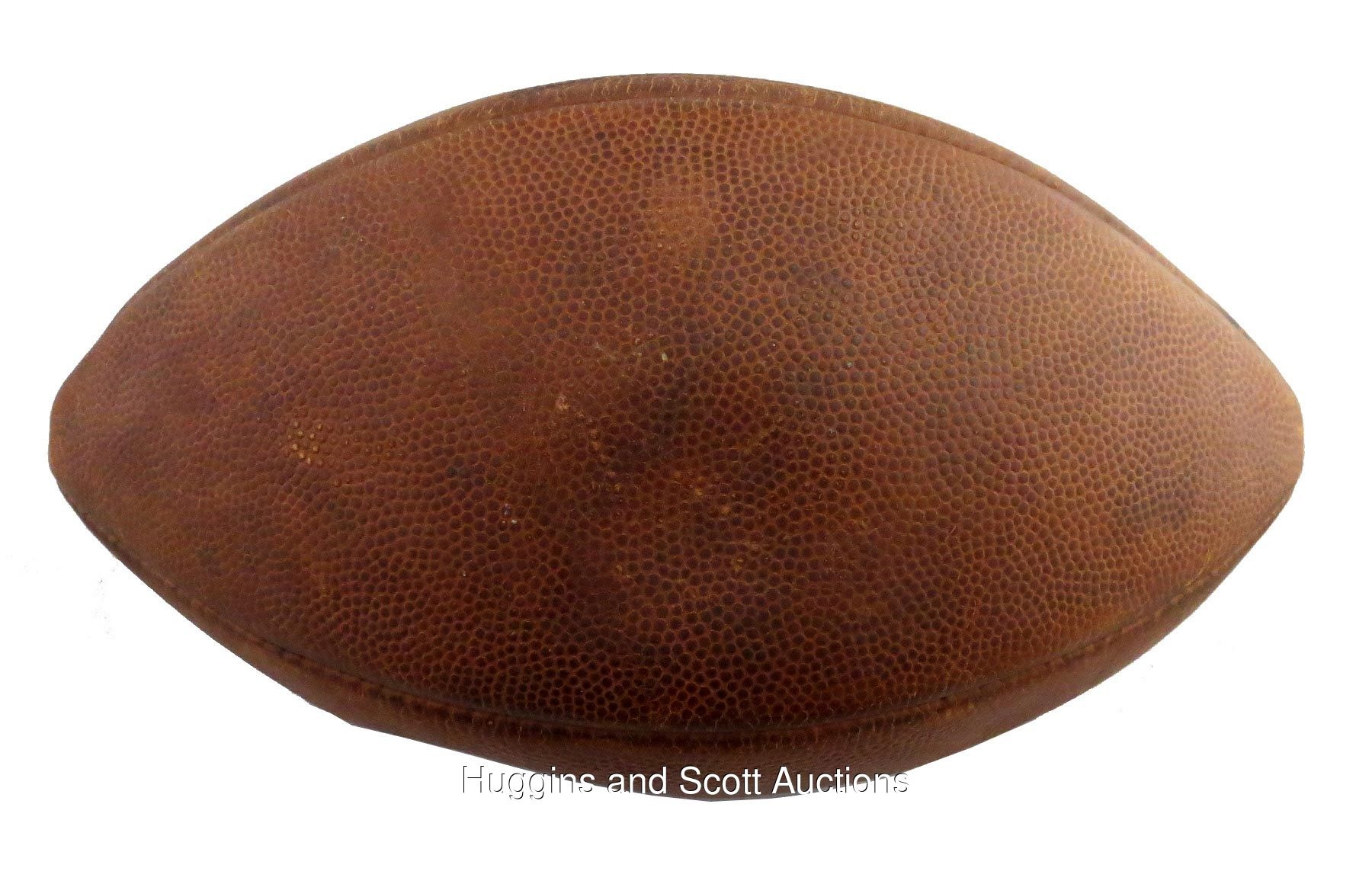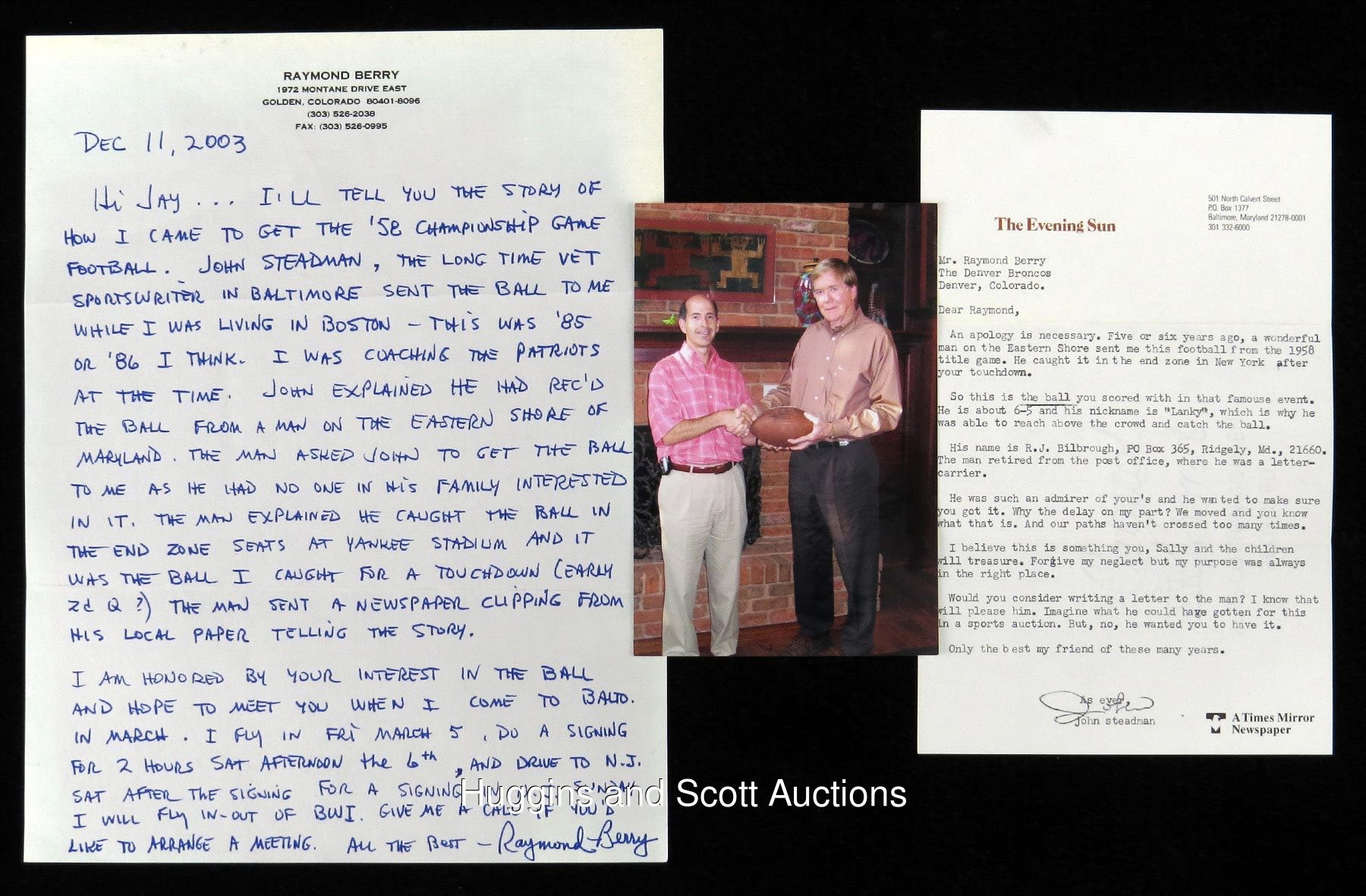Search
Actual Football Thrown From Unitas To Berry for TD Pass in 1958 NFL Championship Game with Impeccable Provenance
- Sold For: $62,140
- Year: 1958
- Auction: 2016 February
- Lot #: 1
- Auction Category: Football Cards or Memorabilia
Independent of one another, a myriad of vital components merge to resonate the aura of perhaps the most mythical event in American Sports history. Boundless pride, fervor and wonder are elicited in beholding arguably the most sacred gridiron relic extant: the very football thrown by Johnny Unitas to Raymond Berry for a touchdown pass in the 1958 NFL Championship game. To Date, the hobby has encountered limited (yet precious) artifacts from that December 28 showdown in the Bronx. Primarily, stadium-issued programs are the final vestiges of an unparalleled contest and era before pride gave way to paychecks and civic loyalty transcended heroes, no matter how great, in other towns. There are scarce few goalpost pieces, as well: small sections of the symbolic and tangible wooden structure that once stood at the front of the end zone awaiting entrants or hoping to deny penetration (depending on who had the ball). But this pigskin trumps every imaginable element from that chilly and, as it turned out, fortuitous afternoon. An overtime triumph by Baltimore is well documented, But the Colts" journey is equal parts intriguing and unfathomable. Ousted from the NFL following a 1-11 showing in 1950, Baltimore (which many justifiably claimed hadn"t deserved a franchise to begin with) landed a second chance as remnants of a moribund Dallas Texans club transferred to Memorial Stadium in 1953. Meanwhile, a young Unitas was deemed "too skinny" by coaches at his beloved University of Notre Dame and thus, reported to the University of Louisville as a 6-foot-1, 145-pound freshman. His mettle on the NCAA gridirons warranted his selection by the Pittsburgh Steelers in the 9th round of the 1955 NFL Draft, but head coach Walt Kiesling determined that Unitas was not smart enough to quarterback in the NFL and resultantly, he never took a single snap in training camp and was the odd man out among four quarterbacks trying to fill three slots. Simultaneously, Berry endured a physical handicap with one leg shorter than the other. He didn"t start on his high school team (coached by his own father) in rustic Paris, Texas and subsequently, caught a combined 33 passes in three seasons at Southern Methodist University. Yet there they were in 1958 on the biggest stage in professional football at the most storied venue in American sports. Their ascent was no great mystery, however. Mirroring the rise of their contemporary Oriole baseball counterparts, the Colts stressed fundamentals and their rise to power was rapid. Under the tutelage of Weeb Ewbank and savvy drafting, the roster collectively honed its prowess. Unitas, for one, was coveted for his signal calling skills, calm under pressure and passing abilities in a run-oriented league. Berry, meanwhile, was prized for precise route-running skills and unrivaled ball control. In his 13-year NFL career, he dropped only two passes and fumbled just twice. Decidedly mercurial with a combined 11 turnovers and four lead changes, the 1958 title game swayed considerably in the Colts" favor as Milt Davis - despite playing with two broken bones in his right foot - forced a Frank Gifford fumble in the second quarter. Fifteen plays later, Unitas completed a 15-year touchdown pass to Berry to culminate an 86-yard drive. Steve Myhra punctuated the score with an extra-point kick that gave the Colts a 14-3 advantage just before halftime. This was the actual ball that was used as the previously unsung victors methodically marched down the field in, with nary an argument, the most influential game in football history. From Unitas to Berry and, subsequently, booted into the stands by North Dakota-born Myhra, this football remains a hallowed heirloom on multiple levels. With "Wilson" trademark stampings, the Bert Bell signature model prize bears a "Thorp Sporting Goods" logo stamping and symmetrically arranged identifiers, including "National Football League - Eastern Conference - Western Conference" in elegant cursive font. Scattered scuff marks inherent to game play only add to the overwhelming aesthetic appeal. The ball inflates to approximately 85%, though presents (at most angles) as though fully inflated. Infinite appeal abounds with impeccable provenance and accountable lineage spanning that historic day at Yankee Stadium to the current moment. Pre-dating the sizable nets raised just before field goal and extra-points are attempted, this souvenir sailed through the goalposts and into the stands at the closed end of Yankee Stadium, where a grocer from Maryland"s Eastern Shore caught it. That loyal fan, in turn, sought out Baltimore Sun fixture John Steadman, forwarding the prized pigskin with instructions to give it to Berry. Steadman complied, of course and, in a cyclical and most appropriate turn of events, the ball landed once again in the capable hands of Berry - just as it had in the end zone on that unforgettable day nearly 60 years ago. Documents composed and signed by the above-mentioned principals accompany, completing ironclad provenance for a keepsake that is without peer. And their content goes beyond mere prose. No, these documents are comprised of heartfelt passages written with a flair to cite the importance of the event and its participants. Steadman, a Baltimore native who did uneventful baseball tours of duty with the York White Roses and Salisbury Pirates in 1945, was a Baltimore scribe for seven decades and was all too happy to forward the ball (and ample praise) to Berry. The ball"s original recipient described the event with stunning clarity, as if the game was played yesterday, and even drew a seating diagram tracking the flight of the ball. Berry, too, recalls the glorious feat proudly, if not humbly. Rightfully cited "The Greatest Game Ever Played," the 1958 championship tilt was viewed by an estimated 45 million (although blacked out in New York) on its NBC national broadcast. The game"s tense and taut nature undoubtedly sparked the boom of subsequent television and on-site audiences. It"s no coincidence that the following year, suits began to form the upstart AFL, which sprouted West Coast franchises and ultimately merged with the NFL and gave birth to the Super Bowl, the biggest sporting spectacle in the world. Commensurately, the casts of the 1958 battle read like a "Who"s Who" among football legends. Mentoring on he Giants sidelines that day, assistant coaches Tom Landry and Vince Lombardi were about to embark on storybook careers of their own. Refusing medical treatment and stationed on the Baltimore sidelines with a broken ankle (incurred in the 4th quarter) Hall of Famer Gino Marchetti looked on through the overtime session as the Colts marched 80 yards in 13 plays against a tired Giants defense. Orchestrated like a minuet, the drive culminated with Alan Ameche"s 1-yard plunge and the lasting images of mud-soaked uniforms, a pitch-black sky and the Yankee Stadium wrought iron facade in he background. In addition to igniting the boon of the NFL, the 1958 championship game also put Baltimore on the sports map. The blue collar city"s enthusiasts, though no less ebullient than fans elsewhere, had been (like their teams) obscured by lager markets to that point. While it"s a certainty that subsequent NFL endeavors were molded by (or at least unfavorably compared to) the epic 1958 title contest, there is no substitute for the original. From what will forever be viewed as pro football"s elixir, this football is beyond comparison in terms of genuine relics that withstood the elements and the rigors of heated competition. This item has a reserve (estimated value: $40,000-$75,000).
